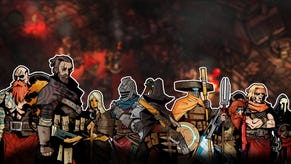Hey, the Creators of Pokémon Released a New Game That You Didn't Know About
Game Freak wants you to know Giga Wrecker exists (and it's pretty cool).
This article first appeared on USgamer, a partner publication of VG247. Some content, such as this article, has been migrated to VG247 for posterity after USgamer's closure - but it has not been edited or further vetted by the VG247 team.
Game Freak's Hiroto Ito and Hiromi Ogawa are here to remind the world that the company behind Pokémon isn't a one-trick Ponyta.
"We love Pokémon, but want the world to know we're not just Pokémon," says Ogawa, a visual effects designer at the studio. "We love to make other games, too."
In fact, Ito explains, Game Freak has recently made a concerted effort to expand the developer's work beyond the popular and reliable Pokémon series. The latest of these efforts, on which both Ito and Ogawa collaborated, is an action platformer called Giga Wrecker. Looking nothing at all like Pokémon, with a hard-edged sci-fi anime look and convoluted 2D platforming action, Giga Wrecker draws instead on the company's legacy of similar games, from cult classic Pulseman for SEGA Mega Drive to cult classic Drill Dozer for Game Boy Advance. It's pretty clear, however, that Game Freak would like to break out of the "cult classic" rut and get into the business of landing hits with its side projects.

"Within our company we have a system, Gear Project," says Ito, who worked as a planner on Pokémon X and Y Versions before moving to smaller projects like Giga Wrecker. "Any employee, whether they're a designer or planner, can propose an idea and create their own game. It's kind of an entrepreneurial venture within the company that we're trying to grow — especially as a sort of outreach to our younger members.
"Gear Project was created in order to continually search for new IPs and keep everyone in the company fresh and searching for new ideas. It was set up about eight years ago, and this is the fourth title through this project. The first was Rhythm Hunter Harmonight, followed by Pocket Card Jockey, and finally my own previous project, Tembo the Badass Elephant.
"We've had games like Harmoknight which were more fantastic, and Pocket Card Jockey which were more comical. And then with Tembo it was like a mascot character in an action movie rampage like Rambo in a cute but heroic way," he said, pantomiming tying on a headband. "This game stars a female protagonist — a cyborg — with a very Japanese animation sort of style, and science fiction themes throughout."
Ogawa adds that "within this Gear Project, each idea is presented by different people with different roles within the company. So each project will produce a game with a completely different feel.
"In a sense, it's something of an appeal to the world in general."

As for Giga Wrecker, Ito describes it as "an action-puzzle game with a well-developed physics system." Players control their cybernetic schoolgirl through a series of somewhat non-linear stages packed with both enemies and opportunities for environmental interactions. The game feels less like a classic 16-bit platformer than Game Freak's other previous works along these lines; it uses a high-resolution "jointed" art style, and the camera is capable of zooming in and out dramatically as the situation requires, similar to contemporary platformers like N+.
The physics system is the star of the show, though, allowing the heroine to perform fairly dramatic feats of environmental action. Ito points at a promo shot in the game's brochure which depicts a large, cross-shaped object standing near a pit. In that case, the design works out to a basic navigational puzzle: You can knock down the cross to create a bridge and pass over to the rest of the stage.
"The concept is that you destroy the environment and objects around you to solve puzzles, defeat enemies, and advance forward," says Ito. However, he stresses that the game offers far more involved applications for the physics engine than simply knocking over bits of debris.

"In this game, there are both destructible objects and environments, and as the heroine proceeds throughout the world she collects debris. There's a transformation mechanic that allows you to use the debris you've collected to create a sword, or to place blocks to allow you to climb or act as a counterweight. As you make use of debris, your collection gets used up, so you have to continue breaking things apart as you play to acquire more.
"So not only are these weapons, but for example, if you were to cut some sort of pillar with this blade, it would fall forward a certain way. If you were punch it with something forceful, it would flip back this way. If you were to use the drill power, it would break through an entire level of blocks and cause the rest to fall."
The debris mechanic also translates well into pure action sequences. The game's first boss, for example, is a heavily armored woman who flies around and arena generating massive swords which she can fling as projectiles and levitate. By parrying a blade, or simply dodging and allowing it to become embedded in walls, you can shatter the enemy's weapon and render it into raw materials for your own use. As your ball of junk accumulates and grows, you can either use it as a thrown object to cause direct damage or transfigure it into a more traditional weapon. In either case, the game requires a sort of push-and-pull design: You can't simply power through the boss, since you need to survive her attacks long enough to turn her projectiles into weapons of your own.

Adding to the complexity of the game design, Giga Wrecker doesn't simply throw a string of simple puzzles and battles at you, but links it all together in a more involved world. "There are some metroidvania aspects with regard to exploration," says Ito. "The story itself is linear, but in terms of exploration there's plenty to discover, like upgrades and power-ups and all sorts of other great stuff to find."
So when does this great-sounding game launch? Well, as it turns out, about three months ago.
"We actually already released the game on Steam back in February," says Ito. "It went into early access last summer with a full release three months ago."
Ito doesn't seem surprised that I hadn't heard of the game, despite having followed the company's non-Pokémon work with interest ever since Drill Dozer. He and Ogawa ruefully admit it hasn't really made much of a blip, and that the company's presence at BitSummit this year was intended to raise general awareness for Giga Wrecker. "We have a lot of experience with game development, but not with publishing and promotion," he admits.

With a laugh, Ogawa adds, "Game Freak actually doesn't have a PR department."
That's a side effect of the startup-style nature of the program behind the creation of Giga Wrecker, she explains. "With the Gear Project, the people participating in it have to do everything. Not just game creation, but promotion as well. We admittedly probably could a better job with that!"
Certainly the game holds up to scrutiny. Despite a surplus of 2D platformers on display at BitSummit, Giga Wrecker still stood out thanks to the complexity of its physics-based play and its moody hand-drawn visuals. Game Freak's booth offered more playable kiosks than any other display at the show, yet I didn't see an open demo unit the entire weekend.
Ito agrees that much of the game's lack of general acclaim probably has to do with its having debuted exclusively on a Steam, which has become an overcrowded and cutthroat platform that makes it difficult for any game to succeed without bring highlighted by a popular YouTuber or Twitch streamer. It sounds like Steam won't necessarily be both Giga Wrecker's cradle and grave, though. "I can't say anything concretely yet, as nothing has been decided, but I'd really like to see this on other platforms as well," Ito muses. "As we get positive feedback from fans, we want to expand this and bring it to other platforms."








